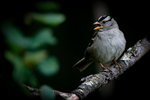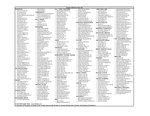

I have written several times that it is not necessary to be able to identify bird species to enjoy watching and listening to them and having them as our neighbors. Yet, for some of you, identifying that bird and knowing its name and habits is something you want to pursue. After all, most of us want to learn the names of our neighbors. If you feel this way, this column is for you.
First, there’s having useful information and equipment. I want to recommend again an essential website and phone app, the Merlin Bird ID program, created by the Cornell Lab of Ornithology. You find it at http://www.allaboutbirds.org. I suggest that you check out the entire website and download their free identification app to your cell phone. The site has links to both Google and Apple web stores.
Having this on your cell phone means that you can look up both appearance and, most important, songs. I find it useful to listen to some of the possible songs I might hear before I go out on a walk. The one weakness of this site is that it covers the entire U.S. My second suggestion is to get yourself a bird list for our local Thurston County birds.
Print it out and then get yourself a magnifying glass. To begin you might want to black out all the rare (4) and (5) species so you can concentrate on learning about birds you are likely to encounter. The species are organized biologically into families, just like the Cornell site, and notated as to how common they are.
[The list came from http://www.wabirder.com/county_map.html If you prefer, go there and then click on Thurston County where you’ll also find this one-page printable list.]
Now, about binoculars. They are very helpful in seeing birds up-close, of course, but new ones can be expensive. Binoculars are described using two numbers (for example, 7x35). The first is the power of the magnification (the end closest to your eye) and the second is the diameter of the lens, light-catching end. This number also measures the field of view – the higher the number the greater territory you can watch when scanning.
If you put “binoculars” into any web search engine you will get more information than you really want. Here are a few suggestions:
Before you buy, see if you can borrow. Give different types and sizes a try – see what you like and what feels comfortable. Be mindful of weight. The larger the numbers the heavier the binoculars and the harder it is to hold them steady.
The price generally reflects the quality of the lenses. If you are a beginner, the extra expense probably is not significant to you.
Now, let’s try it out with a bird that is out there singing right now – the White-Crowned Sparrow. These birds are very common in open areas, hopping on the ground. The males are singing off-and-on all day, usually from a low perch. They have a prominent white crown and eye stripe. Using the Merlin site, listen to the song a few times. (This might also provoke your cat, which is all part of the fun.) These birds are not shy and if you approach slowly, you might see all the key identification features without using binoculars. Bill – stubby, the mark of a seedeater. Wing – two white marks that look like bars. Breast – plain grey; back – brownish streaks, a typical sparrow marker.
A second bird that you might practice with is the Common Yellowthroat. The male has a bright yellow throat patch, a bold black mask and loves to sing. I hear their song as a bright and loud “wit-cha-tee, wit-cha-tee.” It’s one of those songs that, once learned, is easy to remember. Yellowthroats frequent many habitat types, including sometimes overgrown clumps of Scots Bloom, also known as Scotch Broom.
That’s all for this week. Next week we’ll be back to writing more about the birds and less about how to identify them.
George Walter is the environmental program manager at the Nisqually Indian Tribe’s natural resources department; he also has a 40+ year interest in bird watching. He may be reached at george@theJOLTnews.com
Photos for this column are provided by Liam Hutcheson, a 14-year-old Olympia area birder and avid photographer.
1 comment on this item Please log in to comment by clicking here
valerie
We have Merlins in the trees at Good Shepherd Lutheran Church on the corner of North & Henderson. They have come back for the last several springs. They are noisy! Are they rare in the Olympia area??
Sunday, June 26, 2022 Report this